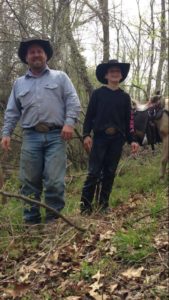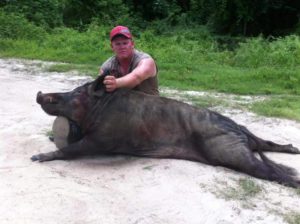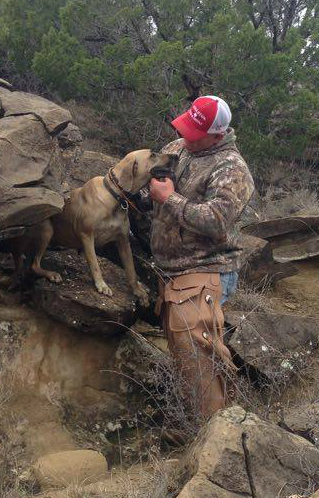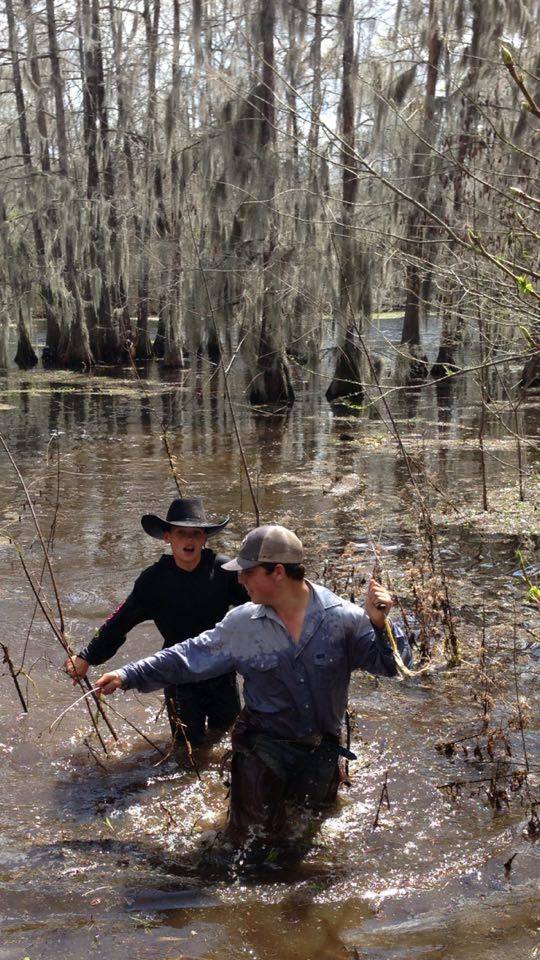Hog-dogging: For fun, profit and environmental protection
“It’s a primal struggle from right back in the caveman days—it’s a primal struggle of life between man and beast and it’s just cool as it can be.”
By Elizabeth Abrahamsen
Rat Race Contributing Writer
It’s a breezy, humid evening in the outskirts of Texas’s largest city. The daylight is fading and the buzz of highway traffic is not far away, but Terry Parker’s plans for this evening don’t take place under the twinkling lights of Houston’s nightlife. Parker is accompanying a group of friends through a 500 acre tract of undeveloped land just outside Richmond, a tranquil Houston suburb.
The men are downwind of a herd of wild hogs that have been wreaking havoc on the land, the future home of a new shopping center. The landowners want the damage stopped, and they have contracted with group leader Kevin Daniels to make that happen. Parker, Daniels and the other men are wild hog hunters. Armed with Garmin Astro tracking units, rope, and Bowie knives they take on some of Texas’s most vicious wild animals for fun and profit.

Wild hogs are an invasive species which number in the millions in the Lone Star State and across the American south. Without hunting, their population grows rapidly. Feral hogs can breed as early as eight months old, and they can have two litters every year. Each year 70 percent of the herd has to be culled just to keep the population stable.
Owing to their prolific breeding ability, along with their classification by the Texas Parks and Wildlife Department as a nuisance animal, there are no restrictions on how you can hunt hogs. Some people hunt them with more sophisticated gear including helicopters, high-powered rifles equipped with silencers, and night vision equipment.
But Parker and his hunting buddies tend to do it differently. Parker is a “hog-dogger,” meaning he uses a pack of specially trained work dogs to hunt and trap wild hogs. Parker relies on experience and the instinct of his dogs rather than on high-tech equipment.
Although descended from domesticated pigs, feral hogs are different from their farm-raised cousins. They are smaller, but can be quite dangerous. Boars have large tusk-like lower fangs referred to as “cutters” which are constantly being sharpened against the upper fangs known as “whetters.” Hogs constantly grind their teeth to keep them sharp. Like the sharpening of a knife, this grinding emits an easily-tracked sound.
“It sounds like someone cracking pecan shells,” Parker said. “Pop! Pop! Pop! You can hear it from maybe 1,000 yards away. They do it to intimidate the dogs, let them know, ‘Hey, I have teeth too.’” Along with being dangerous, wild hogs are also smart. On a hunt outside Wallisville, Texas, Parker, along with Jacob Boul and Hunter Wilson, pursued a boar hog known for its extreme cunning. He had evaded capture multiple times from many hunters and had a reputation among the men.
“[The hog] was bayed in a deep creek by my dogs Ratty and Salt, and Hunter Wilson’s dogs Bo and BeBe,” Parker said. Ordinarily getting cornered is bad news for a hog, but the boar knew what he was doing. “He knew the creek well enough to stand on a sunken log to fight while making all the dogs have to swim.”
The clever boar was finally cornered with the help of an experienced dog named Carlos.
“Carlos was a proven catch dog with lots of hogs under his belt, but this one was different,” Parker said. When the dog swam up to his target he was caught by the hog and tossed down the creek bed. Undeterred, the dog came back time and time again to achieve his goal. Though the scene was tense, the dog was not harmed.
“Carlos survived with nothing more than his pride bruised,” Parker said. “But he never wanted to catch a hog again and I had to let him go to a pet home.”

Parker and hunters like him are often hired by farmers, developers, and other landowners to rid their acreage of entire herds of hogs. Unlike deer and other wildlife, feral hogs are exceptionally destructive. They can root up ground up to three feet deep and create furrows large enough that tractors can’t run over them without being damaged. They dig up seeds and decimate crops, and can do it all in just a few hours of darkness.
Among Parker’s group, the hogs aren’t always killed by the hunters; instead, many are hog-tied and transported to meat vendors to be sold as exotic meat. The fate of the hog depends on the will of the landowner, but butchers statewide will turn feral hogs into various types of sausage. You can find wild hog on the menu at such celebrated restaurants as Austin’s Dai Due and the Y.O. Ranch Steakhouse in Dallas. Live wild boar fetches about 35 to 40 cents a pound from Texas meat vendors.
When one of Parker’s contracts requires killing the animals on site, the act is done by hand with a bowie knife, not a firearm. It’s the involved, physically taxing aspect of the work that attracted Parker to hog-dogging in the first place.
“I’m a pretty hyperactive, short-attention span kind of guy and I never have been very successful at sitting still and being quiet and patient,” Parker said. Other types of hunting that require waiting in a deer stand or duck blind did not appeal quite as much.
“That’s the real reason I chose hogs,” he continued. “I didn’t want to go chase some animal that had no chance.” Parker prefers a more fair fight when he hunts. “Hogs present quite a challenge,” he said. “They’re very athletic creatures, even though they don’t look it—they can run fast and fight hard.” The challenge and sense of competition with a strong, clever opponent is central to the work’s appeal. “It’s a primal struggle from right back in the caveman days,” Parker said. “It’s a primal struggle of life between man and beast and it’s just cool as it can be.”
Parker has been hog hunting for about seven years now, using dogs bred from a black mouth cur given to him by Chance Ward, a hunting friend.
The gift of a dog has a special significance within the hog-hunting subculture. “Dog hunting is a very exclusionary sport,” Parker said. “It’s not easy to break into.” Parker compared the delicate process of finding someone who will trust you with a dog to networking and finding mentors in the business world. “With dogs, no matter what type of hunting you’re doing, you don’t necessarily just share all your genetics or let just anyone breed to your dogs,” he said.
The dogs are an integral part of the equation to Parker. He has loved hunting dogs ever since a hunting trip he took in his youth while spending time with relatives in Louisiana. One day his great uncle’s rat terrier dog accompanied him squirrel hunting: “Next thing I know this little dog is barking up a tree and I was like, ‘Huh, I’ll be danged, there’s a squirrel up there,’ he said.
From that point on he was obsessed. “It got in my blood and I couldn’t help myself,” Parker said. “I couldn’t go to sleep at night or wake up without thinking about dogs, and I just had to get some kind of hunting dog.”
The ownership of that first dog wouldn’t come until more than a decade later, which may have affected Parker’s almost worshipful appreciation of his animal hunting partners.

“Some dogs may have colder noses [meaning a more astute sense of smell], some are probably faster, some other dogs bay more intentionally,” Parker said. “I personally believe that what sets the dogs that I use apart from other people’s dogs is their intelligence. I feel like, I believe anyway, that I’ve been blessed with some really, really smart dogs.”
The process of hunting begins at dusk. Whether on horseback or on four-wheelers, Parker and his group of hunting buddies will set out on the back roads and position themselves downwind. The dogs catch the scent of a hog and set off. The dogs then encircle the hog and “bay” it (keep it at bay by barking). The dogs have GPS trackers on their collars that enable the hunters to find them, and once the hog is located the hunters set loose the “catch” dog (usually an American pit bull terrier) who will rush in and clamp the hog’s nose or ear, distracting it long enough for the men to get in and literally hogtie the animal, at which point the bay dogs take off and go surround another hog and the process starts all over. The hunters drop digital GPS pins on the hog’s location that allow them to go back and collect all the hogs after the hunt is over.
As exhilarating as the hunt is, the game isn’t as important to Parker as the dogs are. “Every time I turn loose of their collars you can just tell in every flick of that dog’s tail and every hair on that dog’s body [that the dog] absolutely loves what he or she does for a living,” he said. “There’s nothing that makes them happier than they are when they’re baying a hog or a group of hogs.”

“We were penning a set of woods cattle, (an east Texas term denoting feral to semi-feral cattle who rarely see people) and it turned into a hog hunt when young dogs found a hog instead and bayed on a trash and tree limb floatilla in some flooded river bottom woods. These boys swam their horses out to the dogs and hog, and killed the hog which spooked their horses back to dry ground and the kids had to swim back out to us.” – Terry Parker
Parker’s relationship with his dogs is the main incentive in his hunting.
“Being out there and catching hogs is great, but to me, what has me addicted is not catching hogs or camaraderie with friends—I am addicted to the love of those dogs. I am all about the dogs,” he said. “If the state of Texas outlawed running hogs with dogs tomorrow I would hate that, I’d be extremely upset, but I would not get rid of my dogs. I’m gonna turn around and go hunt the next thing. I’m gonna go run cottontail rabbits with my dogs, it doesn’t matter to me.”
The cottontail rabbits of Texas are probably safe though. Given the enormous population of feral hogs in Texas, it’s unlikely that their hunting will be restricted anytime soon.
